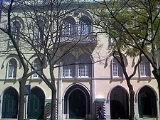
Portuguese National Republican Guard
Encyclopedia
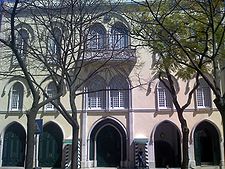
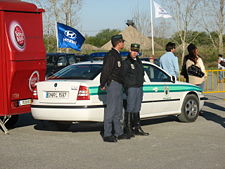
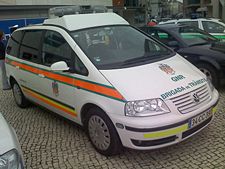
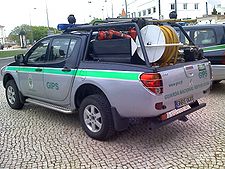
Gendarmerie
A gendarmerie or gendarmery is a military force charged with police duties among civilian populations. Members of such a force are typically called "gendarmes". The Shorter Oxford English Dictionary describes a gendarme as "a soldier who is employed on police duties" and a "gendarmery, -erie" as...
of Portugal
Portugal
Portugal , officially the Portuguese Republic is a country situated in southwestern Europe on the Iberian Peninsula. Portugal is the westernmost country of Europe, and is bordered by the Atlantic Ocean to the West and South and by Spain to the North and East. The Atlantic archipelagos of the...
. Members of the GNR are soldiers, who, unlike the agents of the Public Security Police (PSP)
Polícia de Segurança Pública
The Polícia de Segurança Pública - PSP is the Portuguese police force that works in large urban areas. Rural towns and areas are under the protection of the Portuguese Republican National Guard...
, are subject to military law and organisation. The GNR is responsible for law enforcement in the countryside and small towns (large urban centers are patrolled by the PSP), and providing a national highway patrol
Highway patrol
A highway patrol is either a police unit created primarily for the purpose of overseeing and enforcing traffic safety compliance on roads and highways, or a detail within an existing local or regional police agency that is primarily concerned with such duties.Duties of highway patrols or traffic...
and fiscal guard
Customs
Customs is an authority or agency in a country responsible for collecting and safeguarding customs duties and for controlling the flow of goods including animals, transports, personal effects and hazardous items in and out of a country...
. There are also two military reserve regiments: an Infantry Regiment and a Cavalry Regiment. The GNR also has ceremonial duties and provides guards of honor.
In the 2000s, the GNR has provided detachments for participation in international operations in Iraq and East Timor. , the GNR maintains "Detachment Bravo" in East Timor
East Timor
The Democratic Republic of Timor-Leste, commonly known as East Timor , is a state in Southeast Asia. It comprises the eastern half of the island of Timor, the nearby islands of Atauro and Jaco, and Oecusse, an exclave on the northwestern side of the island, within Indonesian West Timor...
, comprising about 200 personnel, who perform the task of helping to maintain public order in that former Portuguese colony.
Strength
The GNR deploys over 26,000 personnel over 90 percent of Portuguese territory. and they are also deployed in East TimorEast Timor
The Democratic Republic of Timor-Leste, commonly known as East Timor , is a state in Southeast Asia. It comprises the eastern half of the island of Timor, the nearby islands of Atauro and Jaco, and Oecusse, an exclave on the northwestern side of the island, within Indonesian West Timor...
as part of UNTAET and Bosnia as part of IFOR
IFOR
The Implementation Force was a NATO-led multinational peacekeeping force in Bosnia and Herzegovina under a one-year mandate from 20 December 1995 to 20 December 1996 under the codename Operation Joint Endeavour. Its task was to implement the military Annexes of The General Framework Agreement for...
/SFOR
SFOR
The Stabilisation Force was a NATO-led multinational peacekeeping force in Bosnia and Herzegovina which was tasked with upholding the Dayton Agreement. It replaced the previous force IFOR...
/EUFOR Althea
EUFOR Althea
European Union Force Althea is a military deployment in Bosnia and Herzegovina to oversee the military implementation of the Dayton Agreement. It is the successor to NATO's SFOR and IFOR. The transition from SFOR to EUFOR was largely a change of name and commanders: 80% of the troops remained in...
.
Organization
The National Republican Guard is, for police and operating in peacetime, responsible to the Ministry of InteriorMinistry of Interior (Portugal)
The Ministry of the Internal Administration or MAI, is the Portuguese Government department responsible for the public security, the civil defense, the electoral administration, the road traffic safety and the immigration and refugee affairs.The MAI was created in 1736, by King John V of Portugal,...
and military effects of the Ministry of National Defence
Ministry of National Defence (Portugal)
The Ministry of National Defence , MDN, is a Portuguese government ministry.-External links:*...
. In accordance with the Law No. 63/2007 (new Organic Law of the GNR) the traditional structure of the GNR, which included four regional brigades, the Fiscal Brigade, the Traffic Brigade, the Cavalry and Infantry Regiments, were replaced by a new structure, considerably different implemented in early 2009.
The GNR is commanded by a general officer, with the title of Commandant-General
Commandant-General
Commandant-General is a rank in several counties and is generally equivalent to that of Commandant.-Italy:Comandante generale , in Fascist Italy's MVSN, was the title of the head of the Blackshirts, held by Benito Mussolini from 1922 to 1943.Nowadays, is the title held by the commander of the...
(Comandante-Geral)
The National Republican Guard is organized into battalions stationed in the major cities and companies and sections in district capitals and smaller communities.
The National Republican Guard now includes the following:
General Command
- GNR General Headquarters in Largo do Carmo, in Central LisbonLisbonLisbon is the capital city and largest city of Portugal with a population of 545,245 within its administrative limits on a land area of . The urban area of Lisbon extends beyond the administrative city limits with a population of 3 million on an area of , making it the 9th most populous urban...
;
Reporting directly to the Commandant-General are the following:
-
- Direcção de Justiça e Disciplina (DJD); (Directorate of Justice and Discipline)
- Divisão de Planeamento Estratégico e Relações Internacionais (DPERI); (Strategic Planning and International Relations Division)
- Divisão de Comunicação e Relações Públicas (DCRP); (Communications and Public Relations Division).
- Comando Operacional (CO); Operational Command
- Comando da Administração dos Recursos internos (CARI); Command of the Administration of Internal Resources
- Comando da Doutrina e Formação (CDF); Training and Doctrine Command
Territorial Units
The old four-brigade structure was replaced by a system of Territorial Commands. Each territorial command - commanded by a colonel or lieutenant colonel - includes detachments - commanded by Major, Captain or also by a junior officer , Sub - led by junior officers - and regional offices - led by sergeants. Each territorial command usually includes a detachment of transit and a detachment of intervention. The territorial command of the Azores and Madeira play, essentially, just a coastal monitoring and fiscal actions, respectively, under the functional dependence of the UCC and UAF. The current territorial commands correspond essentially to the previous territorial groups of the old territorial brigades. The extinction of the territorial brigades by the end of 2008, the territorial commands placed in direct dependence on the central structure of command of GNR; the commands are as follows:- Comando Territorial dos Açores
- Comando Territorial de Aveiro
- Comando Territorial de Beja
- Comando Territorial de Braga
- Comando Territorial de Bragança
- Comando Territorial de Castelo Branco
- Comando Territorial de Coimbra
- Comando Territorial de Évora
- Comando Territorial de Faro
- Comando Territorial da Guarda
- Comando Territorial de Leiria
- Comando Territorial de Lisboa
- Comando Territorial da Madeira
- Comando Territorial de Portalegre
- Comando Territorial do Porto
- Comando Territorial de Santarém
- Comando Territorial de Setúbal
- Comando Territorial de Viseu
- Comando Territorial de Viana do Castelo
- Comando Territorial de Vila Real
Special Units
Special Units fall directly under the Operations Command (Comando Operacional).- Unidade de Controlo Costeiro (UCC) - (Coastal Control Unit) - Essentially the Portuguese Coast GuardCoast guardA coast guard or coastguard is a national organization responsible for various services at sea. However the term implies widely different responsibilities in different countries, from being a heavily armed military force with customs and security duties to being a volunteer organization tasked with...
, is commanded by a Major General, is responsible for surveillance and interception at sea and coast, including the operation of the Integrated Surveillance, Command and Control (SIVICC), distributed along the Portuguese coast. This unit replaced the former Maritime Services Fiscal Brigade ; - Unidade de Ação Fiscal (UAF) - (Fiscal Action Unit) - commanded by a colonel, is responsible for carrying out the mission of taxation, tax and customs attributed to the GNR. It succeeded the previous Fiscal Brigade;
- Unidade Nacional de Trânsito (UNT) - (National Transit Unit) - the national Highway PatrolHighway patrolA highway patrol is either a police unit created primarily for the purpose of overseeing and enforcing traffic safety compliance on roads and highways, or a detail within an existing local or regional police agency that is primarily concerned with such duties.Duties of highway patrols or traffic...
, is commanded by a colonel, is responsible for standardization of procedures and training under the supervision of traffic. This unit replaced the central structure of the former Traffic Brigade, losing its territorial subunits transit, which went to the dependence of the various command authorities; - Unidade de Segurança e Honras de Estado (USHE) - (State Security and Honor Unit) - commanded by a Major General, is responsible for tasks of representation and facility security organs of sovereignty. Includes the Esquadrão Presidencial (Presidential Squadron), Charanga a Cavalo (Charanga Horse), the Banda da Guarda (Band of the Guards), the Grupo Honras de Estado eo Grupo de Segurança (State Honors and Security GroupS). This unit replaced the old Regimento de Cavalaria (Cavalry Regiment) and the Regimento de Infantaria (Infantry Regiment);
- Unidade de Intervenção (UI) - (Intervention Unit) - commanded by a Major General, is responsible for the missions of maintaining and restoring public order, management of critical incidents, tactical operations, security of sensitive installations, inactivation of explosives, protection and relief and projection of forces for international missions. Includes Grupo de Intervenção de Ordem Pública (GIOP) (Public Order Intervention Group) and Operações Especiais (GIOE) (Special Operations), Grupo de Intervenção de Proteção e Socorro (GIPS) (Intervention Group for Protection and Rescue), the Grupo Operacional Cinotécnico (Canine Operational Group), Centro de Inativação de Explosivos e Segurança em Subsolo (CIESS) (Center for Explosives Disposal Underground Safety) and Centro de Treino e Aprontamento de Força para Missões Internacionais (Force Training and Readiness Centre for International Missions). This unit was organized with several subunits of the former Infantry Regiment.
Services
- Serviço de Protecção da Natureza e do Ambiente- SEPNA (Nature and Environment Protection Service)
Educational establishment
Guard School (EG) - commanded by a Major General, is responsible for technical and professional training of military personnel of the GNR. Includes training centers in Figueira da Foz (CFFF) and Portalegre (CFP). Succeeded the former Guard Training School.History
The National Republican Guard is the direct descendant of the Royal Police Guard created in the beginning of the 19th century.Royal Police Guard, 1801
The Lisbon's "Royal Police Guard" (Guarda Real da Polícia) was created in 1801 by Prince Regent JohnJohn VI of Portugal
John VI John VI John VI (full name: João Maria José Francisco Xavier de Paula Luís António Domingos Rafael; (13 May 1767 – 10 March 1826) was King of the United Kingdom of Portugal, Brazil and the Algarves (later changed to just King of Portugal and the Algarves, after Brazil was recognized...
on the initiative of the Intendant-General of the Police of the Court and the Kingdom, Pina Manique
Pina Manique
Dr. Diogo Inácio de Pina Manique was a Portuguese magistrate.He was the son and heir of Pedro Damião de Pina Manique , who succeeded his father in the ground-rent of Knight-Fidalgo of the Royal Household Dr. Diogo Inácio de Pina Manique (Lisbon, Santa Catarina, 3 October 1733 — Lisbon,...
. It took as a model the French Gendarmerie (1791). Following the creation of the Lisbon's Royal Police Guard, the a Royal Police Guard was created for Porto and another for Rio de Janeiro
Military Police of Rio de Janeiro State
The Military Police of Rio de Janeiro State like other military polices in Brazil is a reserve and ancillary force of the Brazilian Army, and part of the System of Public Security and Brazilian Social Protection...
. The latter subsequently provided the origin of the Military Police forces of the member states of Brazil
Brazil
Brazil , officially the Federative Republic of Brazil , is the largest country in South America. It is the world's fifth largest country, both by geographical area and by population with over 192 million people...
.
Municipal Guard, 1834
At the end of May, 1834, as a result of the Civil WarLiberal Wars
The Liberal Wars, also known as the Portuguese Civil War, the War of the Two Brothers, or Miguelite War, was a war between progressive constitutionalists and authoritarian absolutists in Portugal over royal succession that lasted from 1828 to 1834...
, King Peter IV, assuming the regency in name of his daughter Queen Mary II, disbanded the Royal Police Guard in Lisbon and Porto, creating the "Municipal Guards" of Lisbon and Porto on the basis of similar conditions. In 1868 both of the Guards were put under a unified General Command, installed in the Carmo Barracks in Lisbon, which today still is the Headquarters of the GNR. The Municipal Guard was considered part of the Army, but was dependent on the Ministry of Internal Affairs for all matters regarding public security.
Republican Guard, 1910
After the coup of the 5 October 1910, which substituted the Constitutional Monarchy with the Republic, the new regime changed the name of the Municipal Guard to the Republican Guard (Guarda Republicana).National Republican Guard, 1911
In 1911, the name changed to National Republican Guard: this was to be a security force consisting of military personnel organised in a special corps of troops depending, in peace time, on the Ministry of Internal Administration, for the purpose of conscription, administration and execution with regards to its mission, and the Ministry of the National Defense for the purpose of uniformization and normalization of the military doctrine, as well as for its armament and equipment. In case of war or situation of crisis, the forces of National Republican Guard will, in terms of the respective laws and for operational effect, be subordinated to the Commander-in-Chief of the Armed Forces. In 1993 the National Republican Guard absorbed the independent Fiscal Guard (Guarda FiscalGuarda Fiscal
The Guarda Fiscal was a Portuguese special military force, tasked with the border and maritime control of people and goods and the law enforcement, particularly in the fields of taxation and customs....
) that became the Fiscal Brigade of the GNR. In 2006 a new GNR unit was created with the purpose of firefighting and was named GIPS.
A small contingent of GNR forces has been deployed in Timor-Leste in 2006 (see video below).
Equipment
The police in Portugal always used a wide range of firearms to equip their personnel. At the start of the 21st century they choose Glock 19 as the standard Law Enforcement handgun which came only to replace the old Walther PP. Any other handgun in a caliber above .32ACP will remain in service.Handguns
- FN Browning HP (9x19mm Parabellum) since 1935;
- Beretta Px4 StormBeretta Px4 StormThe Beretta Px4 Storm is a semi-automatic pistol manufactured by Beretta of Italy and intended for personal defense and law enforcement use. The Px4 uses the same short-recoil, rotating barrel lock as the Beretta 8000 Models and uses the same operating system as the M9/92/96 series, while being...
(9x19mm Parabellum); - Glock 17 (9x19mm Parabellum);
- Glock 19 (9x19mm Parabellum); (Standard pistol)
- HK P9S (9x19mm Parabellum);
- HK VP70M (9x19mm Parabellum);
- HK USP Compact (9x19mm Parabellum);
- HK P30 (9x19mm Parabellum);
- SIG GSRSIG GSRThe SIG Sauer GSR "Granite Series Rail" pistol is a stainless steel frame and slide M1911 clone produced by SIG Sauer. The SIG Granite Series was awarded the 2004 Handgun of the Year Award by the Shooting Industry Academy of Excellence...
(.45ACP) - SIG P220SIG P220The SIG P220 is a semi-automatic pistol designed in Switzerland by Swiss Arms AG . It is manufactured in Eckernförde, Germany, by J.P. Sauer und Sohn GmbH. It uses the Browning linkless cam short recoil action of self-loading with a double action trigger mechanism...
(9x19mm Parabellum); - SIG P226SIG P226The SIG P226 is a full-sized, service-type pistol made by SIG Sauer. It is chambered for the 9×19mm Parabellum, .40 S&W, .357 SIG, and .22 Long Rifle. It is essentially the same basic design of the SIG P220, but developed to use higher capacity, staggered-column magazines in place of the...
(9x19mm Parabellum); - SIG SP2022 (9x19mm Parabellum);
- Walther P99Walther P99The Walther P99 is a semi-automatic pistol developed by the German company Carl Walther GmbH Sportwaffen of Ulm for law enforcement, security forces and the civilian shooting market as a replacement for the Walther P5 and the P88...
(9x19mm Parabellum); - Walther P38 (9x19mm Parabellum);
- Walther P5Walther P5The Walther P5 is a 9mm semi-automatic pistol developed in the mid-1970s by the German small arms manufacturer Carl Walther GmbH Sportwaffen. It was designed with the German police forces in mind, who sought to replace existing 7.65mm pistols with a modern service sidearm incorporating enhanced...
(9x19mm Parabellum); - Walther PP (7.65x17mm (.32ACP)); (replaced by Glock 19)
Shotguns
- Mossberg 590; (12 gauge);
- Winchester 1200Winchester 1200The Model 1200 and Model 1300 were two American pump-action shotguns that were manufactured by the Winchester-Western Division of Olin Corporation. It was produced in 12-, 16- and 20-gauge. The 1200 has the ability to have a bayonet fixed on the end of the barrel to be used in close quarter combat...
(12 gauge); - Fabarm SDASS TacticalFabarm SDASS TacticalThe Fabarm SDASS Tactical is a shotgun designed for police and/or security uses and has some special features such as folding front sight, built-in Picatinny rails on the top of the receiver, lengthened forearm to provide better control over the gun...
(12 gauge); - Benelli M3Benelli M3The Benelli M3 is a dual-mode shotgun designed and manufactured by Italian firearms manufacturer Benelli. The M3 holds a maximum of seven rounds and uses the proprietary Benelli semi-automatic system first showcased in the M1. The M3 is notable for allowing the user the choice of semi-automatic...
(12 gauge); - Benelli M4 (12 gauge);
Sub-Machineguns
- FAMAE SAFFAMAE SAFThe FAMAE SAF is a submachine gun produced since 1993 by FAMAE , the Chilean government small arms factory...
(9x19mm Parabellum); - HK MP5 (9x19mm Parabellum);
Rifles
- HK G36 (5.56x45 NATO);
- HK G3 (7.62mm NATO).
- HK MSG90 (7.62mm NATO).
- Accuracy International AW50Accuracy International AW50The AW50 is a .50 BMG anti-materiel rifle designed by Accuracy International. It is a re-engineered version of the Accuracy International Arctic Warfare L96 sniper rifle .-Users:-See also:...
(.50BMG)
See also
- PortugalPortugalPortugal , officially the Portuguese Republic is a country situated in southwestern Europe on the Iberian Peninsula. Portugal is the westernmost country of Europe, and is bordered by the Atlantic Ocean to the West and South and by Spain to the North and East. The Atlantic archipelagos of the...
- National Guard (disambiguation)
- CarabinieriCarabinieriThe Carabinieri is the national gendarmerie of Italy, policing both military and civilian populations, and is a branch of the armed forces.-Early history:...
- Civil Guard (Spain)Civil Guard (Spain)The Civil Guard is the Spanish gendarmerie. It has foreign peace-keeping missions and maintains military status and is the equivalent of a federal military-status police force. As a police force, the Guardia Civil is comparable today to the French Gendarmerie, the Italian Carabinieri and the...

